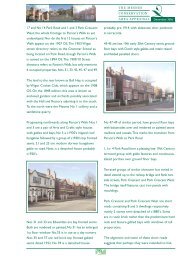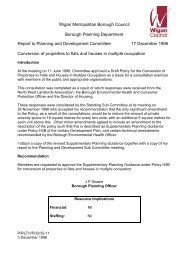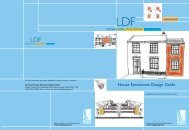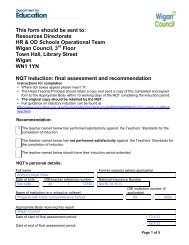Level 2 Strategic Flood Risk Assessment (.pdf ... - Wigan Council
Level 2 Strategic Flood Risk Assessment (.pdf ... - Wigan Council
Level 2 Strategic Flood Risk Assessment (.pdf ... - Wigan Council
Create successful ePaper yourself
Turn your PDF publications into a flip-book with our unique Google optimized e-Paper software.
Again, avoiding generalities, we have not simply “assumed” but have instead assessedeach of the identified sites and defence locations to confirm whether or not defencesprovide a continuous extent of protection to individual sites. As defences are currentlybetween a 40 and 50 year standard they will be overwhelmed during the design eventscenario.Working with the <strong>Council</strong> we have focused our assessment on avoiding, where possible,development in high risk areas. <strong>Assessment</strong> of breach scenarios for lower return periodsis significantly less onerous than designing to the 100 year (including climate change)scenario. <strong>Assessment</strong> of these lower events does not alter any substantive informationor the conclusions in the Sequential Test Spread sheet. The EA are correct not to pursuethis issue further.EA comment:We would agree with JBA and the assumed ‘undefended scenario’ for sequential testingof key regeneration sites.However it is also noted by JBA that all but key regeneration sites have been deleted inflood zone 3. PPS25 is clear in that where development cannot be located outside of highflood risk areas, the level 2 SFRA should provide further information to satisfy the‘Exception Test’. (See response to <strong>Flood</strong> <strong>Risk</strong> Guidance below).Again this has been achieved in consultation with the <strong>Council</strong>. The remaining sites withinhigher risk areas have been identified by you as being key to regeneration within <strong>Wigan</strong>.The SFRA cannot, in itself, determine whether or not the Exceptions Test can be“satisfied”. The EA is wrong to suggest that the SFRA can achieve this as considerationsfor the Exceptions Test are dependent on a variety of planning issues and constraints.The SFRA does, however, provide the flood risk information that the <strong>Council</strong> requires tomake these informed planning decisions. There are three parts to the Exceptions Test:The <strong>Council</strong> must demonstrate that:a. The development provides wider sustainability benefits to the community thatoutweigh flood risk, informed by the SFRA…b. The development should be on developable previously-developed land or, if it isnot on previously developed land, that there are no reasonable alternative sites…The <strong>Council</strong>/developer must also preparec. An FRA that demonstrates that the development will be safe, without increasingflood risk…EA comment:River Douglas <strong>Flood</strong> Alleviation SchemeWe are aware from discussions for a proposed development site within <strong>Wigan</strong> TownCentre, that the <strong>Council</strong> has already commissioned JBA to develop a breach model forthe defences on the River Douglas.As far I we are aware this is a breach model of one particular defence and not the“defences on the River Douglas”.2009s0578-S-L007-1.doc 3/710 December 2010www.jbaconsulting.co.uk
















